How can it be? We depart tomorrow morning. Today is it.
The last several days the agenda has been so big that we showed great restraint upon arriving at the property and stole into the sewing room while the children were still in the classrooms to be able to get started on meetings before being spotted. Of course this was only partially successful, with many pairs of eyes peeping in at us. We imagined them whispering, “Good morning, Madame. How are you?” They are very used to us being playful with them each morning. But, this morning, being our last time with our favorite friends for many months, there was no way we were going to miss spending at least a little time with them.
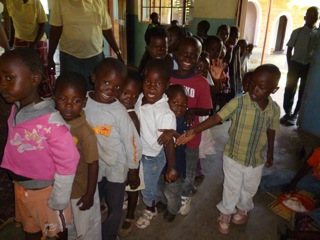
The children were lined up for lunch when we arrived. Joseph was objecting to something about the line—we weren’t sure what.
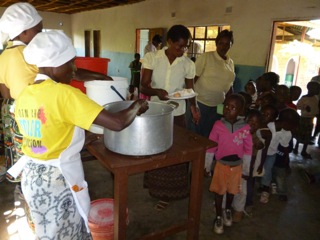
Tuesday: eggs with rice and tomato sauce. The boiled eggs are a huge favorite.
All the preschoolers eat at the same time (several hundred children!) so it is an all- hands-on-deck affair. Any grown-up who is available jumps in to assist the cooks.

Here Rose, Veronica and Ethel help dish out food.

We heard little voices coming from behind the serving team “Kopeniko!” “Take my photo!”
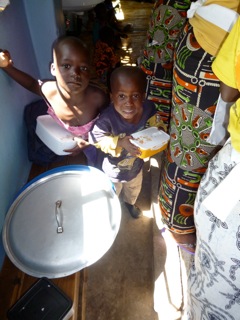
Bruce, the little fellow in the purple shirt with the yellow and white lunch box, has stolen our heart. We told Theresa this; her reply, “I told you!” She knew he would endear himself to us. He has this adorable square head, looks like a grown man in a tiny body and has an outrageously wonderful personality. We’re sure he could easily fit in one of our suitcases now that all those t-shirts are off-loaded!
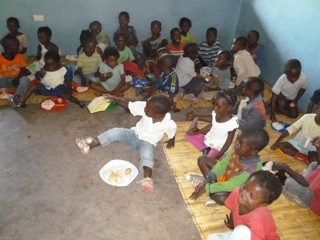
The relative calm of this many children in one room is impressive.
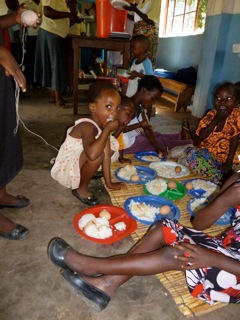
Cheri and friends enjoying their meal.
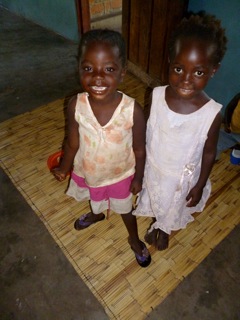
We respond to more requests of “kopeniko.”
It only just occurred to us that this could be a great opportunity to teach the children the English version: “Would you please take my photo?” And then respond only to the English requests. That would be very effective! Next trip.
Soon the government school children began arriving, some before they went off to class and others that had finished school for the day. We were buoyed by our realization yesterday that the training in showing up consistently is all we are attempting to accomplish currently, and the stars charts are very effective for that. So, we were undeterred by the continuing unpredictability of exactly when various grade levels arrived. That’s relaxing!
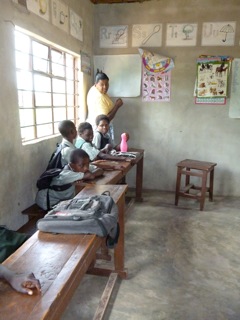
Theresa works with a group of Grade Four students on their chart.

Another All Star in the making.
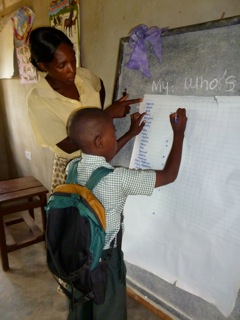
Later, Susan helps with the Grade Threes.
It worked perfectly that today was one of the days Rose is at the property. This was the first time she had seen Living English in action. We are eager for her to be a part of the team to really support the children to grow deep roots in this process. Rose has a perspective that some on the team do not, simply because of life circumstances and experiences. She lives outside Kantolomba and has a nursing career, which required a lot of training. She understands the value of education and the link between exposure and motivation. She was a wonderful asset today in nurturing the students’ early demonstration of commitment (the many students who are already getting it, and showing up every day).

Rose going over the concept of being here “Monday, Tuesday, Wednesday…”
Grades One and Two are blazing the trail. They have by far the largest number of All Stars. In fairness to their older cohorts, this is partly because the time of their government school day has remained stable. This is more evidence that once those schedules settle in, the Living English program can as well.
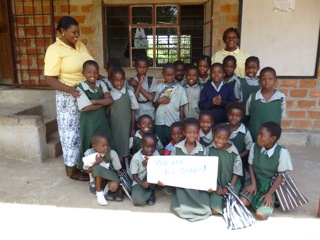
Grade Two All Stars pose for a team photo with Theresa. They are definitely upping their game!
We have been encouraging the grown-ups to approach working on their own English as the best service they can offer the young people they teach/mentor. As Veronica put it, “The children learn from our English, and so we want our English to be correct.” We have been looking at ways to assist the grown-ups to see themselves as active students of English, as well as teachers.
After lunch today, we had the chance to try out an idea we had for this: we took short videos of the adults speaking. The first benefit is they heard how they sound. It can be difficult when we are speaking another language—because there’s so much going on: remembering the words, the grammar, etc.—to hear that we don’t sound like the native speaker who is speaking with us. The second is that this video will be a record of each teacher’s English today, and they can listen to the recording in six months, a year… and be able to hear how their English has improved. In explaining our motivation for making the videos, we used the analogy of a child growing. Someone who sees the child every day does not notice the changes because the growth is gradual. Then someone who hasn’t seen the child for six months remarks on how much the child has grown! And so it is with our English learning, We don’t hear how we are improving because the growth is gradual, but if we have a record of how we sounded six months ago, then we can hear the difference! The team got the idea, and jumped in to making the video clips.
Later, some of the children got in on the action and wanted to make a video to document their current English.
That afternoon Theresa had a fabulous brainstorm. The day before, a vendor had come by the Living Compassion property selling simple English readers. These are the Zambian equivalent of “Dick and Jane,” for any of you who grew up with those I Can Read series. What’s great about them is that they are relevant to Zambian lives and use Zambian names, Zambian settings, foods, etc. We all discussed it and bought 10 of the level one books as an experiment. Could we use these books in small groups to get the children actually reading? Perhaps you remember from past blogs that a child can pass from one grade to the next to the next without ever learning to read independently. The first time this becomes evident is going from grade 7 to 8 where each student must pass a national, standardized test to reach grade 8. The passing rates are very low, all over the country.
While Charles was working with his students, Theresa joined them to say hello (she makes it a point to greet every class of students every day) and asked what they were doing. Charles said they were about to do some reading—he was going to get a book to read to them. Theresa remembered the new readers, got them, and passed them out. They were perfect. The books are level one, meant for very beginning readers, and they were just the right level for these grade 6 and 7 government students. Some could read the books fairly proficiently, some could read some but not all, and a handful could read very little. This could have been a moment of despair, but it felt quite the contrary. What we know about Charles is that he is a dedicated, effective teacher. It has taken until now for the materials, the idea, and the resources to come together to provide this learning-to-read opportunity, but here it is and we’re very excited. Once a group of students masters the level one books (likely to be very quickly for these older students), then we can purchase level two books and so on.
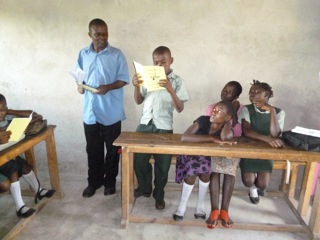
Charles calls on the first, brave volunteer to stand and read for the class.

This young girl was quite a good reader already, at least in this level book.
Mary reading.
At the end of the reading lesson we invited the girls to stay and have a special chat. As we have alluded to throughout this trip, it is becoming clearer and clearer just what an uphill climb it is for a girl to stay in school. One benefit of our visits is that we are a rarity, a break in their day-to-day lives. Theresa tells us she notices a significant increase in their interest and enthusiasm when we are here. And yet, from the work we do with them, we can tell that the interest in learning is genuine and goes well beyond just a desire to spend time with us. We have been discussing, as a team, how to foster the continuation of this enthusiasm even when we are not here. We decided to gather the girls to see what they would like, what would most support them.
It was a great conversation and we came away with two main understandings:
1. They are desperate to learn to read.
2. They need support .
Point one is absolutely doable and Theresa is on it! She is going to start them with the level one readers, and we shall see who wishes to stick with it and work her way up through the levels. Point two is the beginning of what will likely be a process over the next months and future trips. They need material support: school fees paid when their families cannot manage, uniforms, etc., and they need emotional and social support. They talked about how most of their friends their age are now going to dance and drink at the bars. Many are getting married, having babies. These girls do not wish to go that route, but it is the water they swim in. Theresa made it very clear in the conversation that she and the other women on the team (apparently they gravitate especially towards Joy and Josephine who they see as young and more like them) are available anytime for anything they want to talk about or need assistance with.
A number of the Bridge Walk shirts we came with were children’s sizes, enough so that we could give one to each member of our new sub-team “Stay in School!” They were thrilled and we hope it can serve as some small symbol of our “teamness”—it is challenging, but we are in this together!
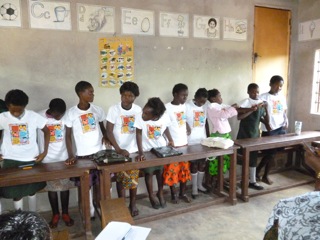
Team Stay in School trying on their new shirts
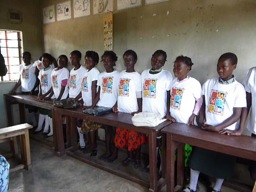
The whole team dressed in uniform
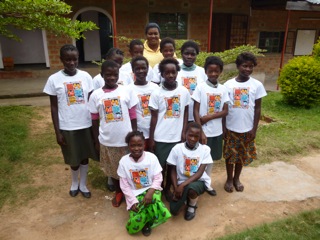
A team photo with Head Coach!
Right on schedule, our dedicated Grade Eight students arrived, and we got to have another photo practice session. Once Team Stay in School gets some reading under their belts, they are next up to join the reporting team.

Adrian captures his teammates on film.
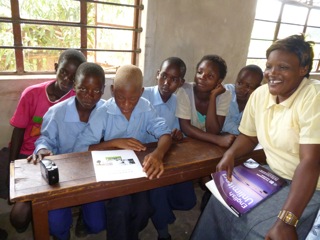
After the practice session Anna shared a printout of the Masala Clinic trip report they had written together. (Visit the weekend blog to read your copy.) That was a big hit.
[swf file="http://www.livingcompassion.org/sites/default/files/africablog/18-22.flv" params="width=640&&height=480"]
One of the several farewell songs.
In the car on the way home Theresa commented, “I LOVE when you guys are here. I love every minute of it. So much happens! At the end of every day I crawl into my bed, so tired.”
And so it is for us, at the end of each day, at the end of a glorious trip, we crawl onto the airplane, indescribably grateful for whatever it is that offers us the good fortune to participate in Life in this way. It is the George Bernard Shaw quote: “This is the true joy in life, the being used for a purpose recognized by yourself as a mighty one; the being thoroughly worn out before you are thrown on the scrap heap.”
And thank you for taking the journey with us. It is of tremendous support to know that you are reading these reports and, we project, being inspired by all that is unfolding in Kantolomba. It is your dedication, enthusiasm, and generous support that is making all of this possible. One of the things we hear over and over during the beautiful goodbyes from the team, “Please greet all of the people in America (they mean you) and give them our love.” So, consider yourself greeted and loved.
We bid you adieu, in this forum, until next time.
In Deep Gassho,
The March 2014 travel team
